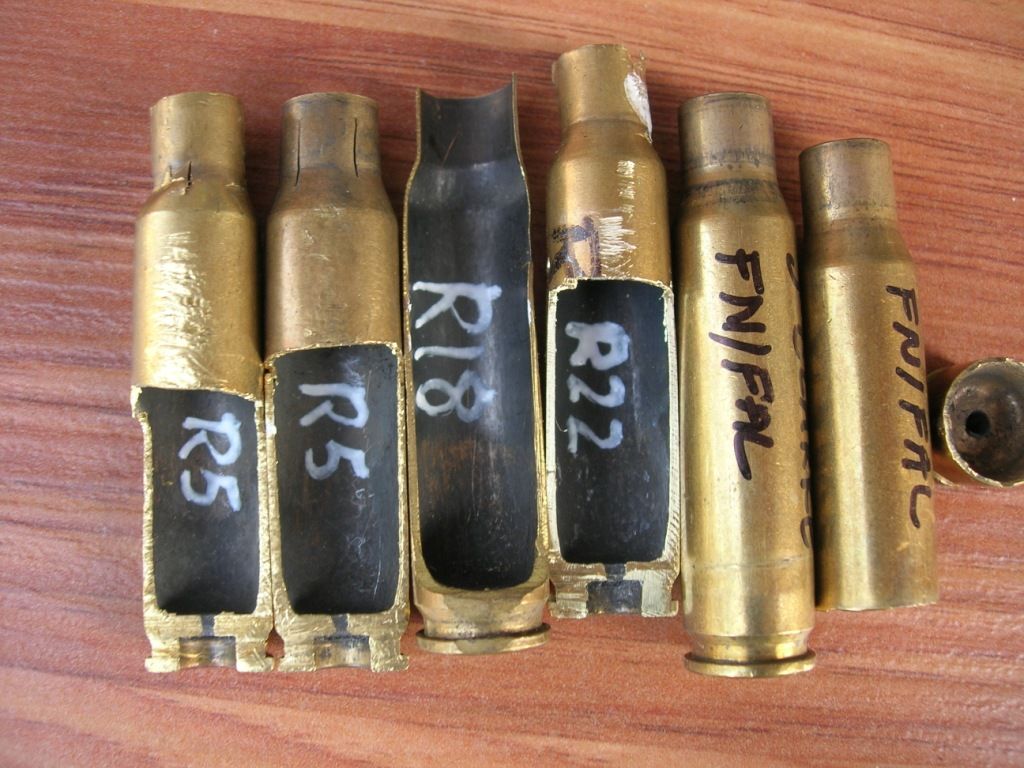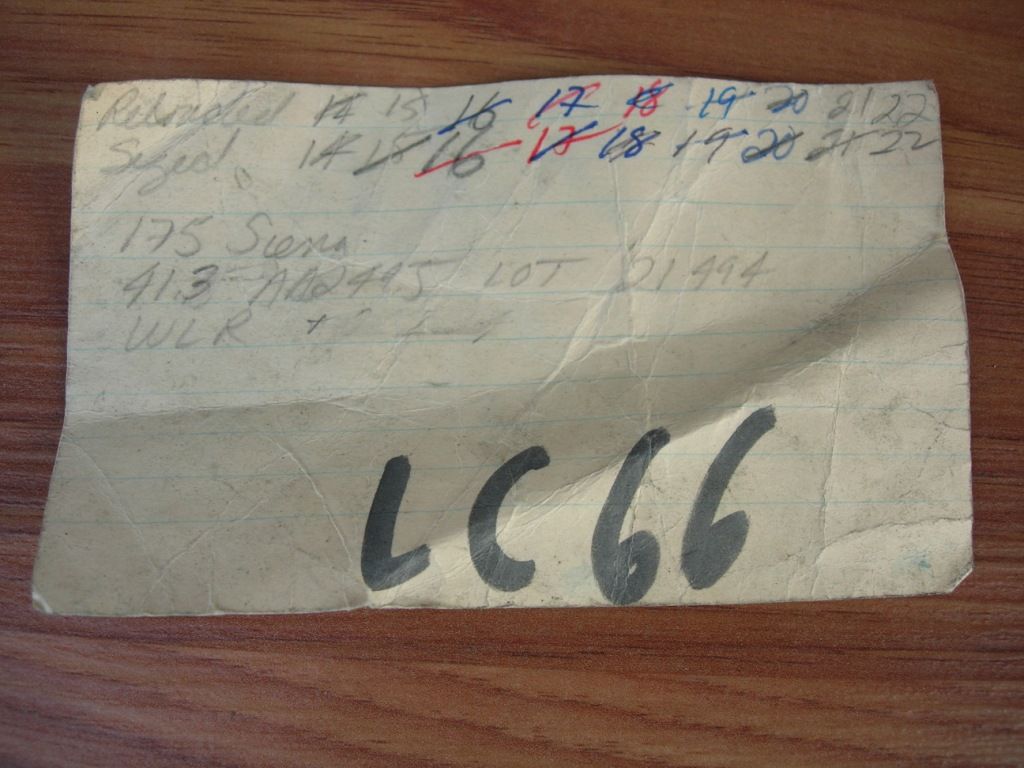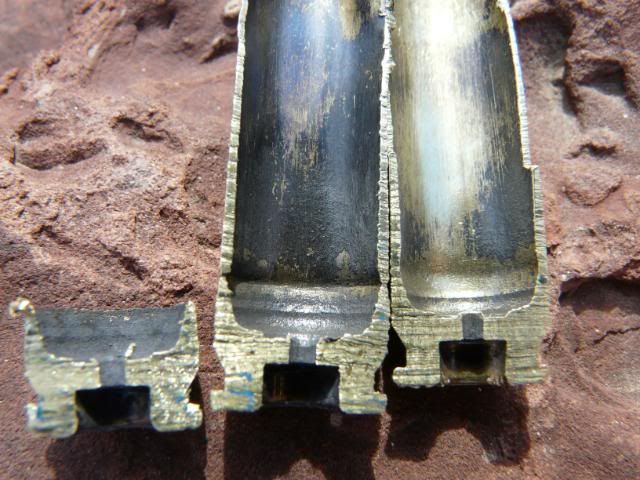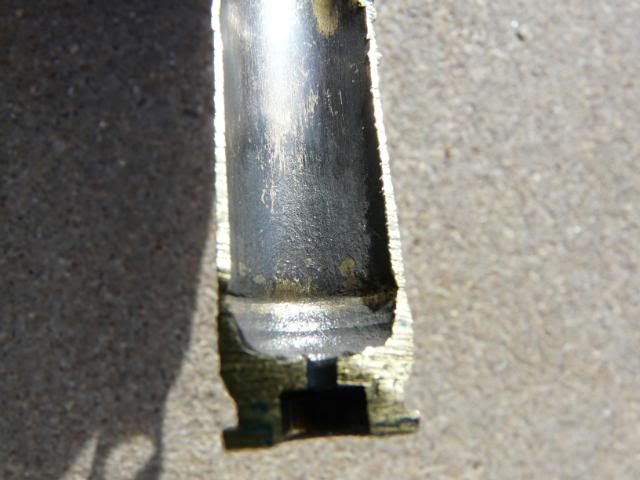
 |
|
|
#1 |
|
Member
Join Date: March 11, 2015
Location: louisiana
Posts: 79
|
brass life
i have recently started handloading for my rilfes and i am currently working up a load for my .270 win. started with factory winchester brass i had saved a couple boxes worth of brass. ive loaded them for the 4th time tonight with no signs of case wear at all. I have read alot as far as brass life but i see alot of people say they crush there rifle brass after 3 or 4 firings. is this a pretty safe point to discard the brass for saftey concerns or is a lot of case life being wasted by only loading 3 or 4 times?
|
|
|
|
|
#2 |
|
Staff
Join Date: March 11, 2006
Location: Upper US
Posts: 29,011
|
It depends on the specific factors involved. Under most circumstances, people who crush cases after 3 or 4 firings are throwing their money away.
In some (fairly rare) instances, they are not. Case life depends on how much the brass is worked during the cycle of loaded ammo to loaded ammo again. Some of that "working" of the brass comes from the pressure of firing. The rest from the reloading process. The hotter the load, the shorter the case life. The larger the difference in dimensions between your sizing die and your gun's chamber, the shorter the case life. Rifle brass usually fails at the case head (actually at the point where the solid case head turns into the case wall). Pressure from firing stretches the brass and this point gets "thinnest, firstest". Do a search for "paperclip check" and you'll find a simple method for determining when cases are getting close to failing. Pistol brass (and straight case rifle brass) usually fails at the case mouth (cracks) The cycle of firing, sizing, flaring, straightening and crimping over and over works the case mouth more than any other part of the case. This can be extended by annealing. Hope this helps
__________________
All else being equal (and it almost never is) bigger bullets tend to work better. |
|
|
|
|
#3 |
|
Member
Join Date: March 11, 2015
Location: louisiana
Posts: 79
|
i have read a little about what you mentioned. I did check the brass with a paper clip i felt no grove yet by the case head. I have no shinny ring on the outside yet either. I did trim a couple thousandths off so i know the brass is flowing i just dont know how long its going to take to show any real signs. as i said its been used to work up a load and i am still 2 grains shy of max load so i dont think its seen any really extreme pressure yet.......which is kinda why this question started in my head i guess lol.
|
|
|
|
|
#4 |
|
Senior Member
Join Date: November 23, 2009
Posts: 3,963
|
If you're 2 grains below maximums, you'll get decent case life, a dozen loadings if you don't work it too much. Trimming .002 isn't required. As mentioned above, learn to anneal, basically a water bath and a torch, around the tenth load cycle.
|
|
|
|
|
#5 |
|
Senior Member
Join Date: September 15, 2005
Location: Oregon
Posts: 1,033
|
I generally don't trim until it grows around .010 or near to, and in a bolt rifle you should be able to get well more than four loadings unless your die is really oversizing your cases. Watch for the case thinning a little closer as you get more loads on the cases, but if they aren't thinning and still size easily they should be safe to load. At some point the brass will become work hardened at the neck/shoulder and it may feel noticeably harder to resize, lose neck tension and possibly start splitting some necks. At that point you'll have to decide if they are worth annealing or tossing out. So far I haven't felt many cases had enough life left to be worth the trouble but it really depends on your individual chamber and your sizing die (or sizing idie adjustment) and ease of obtaining more brass.
|
|
|
|
|
#6 | |
|
Staff
Join Date: March 11, 2006
Location: Upper US
Posts: 29,011
|
I've been reloading since the early 70s, and this got me curious..
Quote:
I have to wonder who has been saying that, and if other information they are giving out is equally "valid". One of the more common instances where you do seldom get even "regular" case life is the .303 British. Civilian rifles in .303 Brit are rare in the US, and the various Numbers and Marks of the SMLE are common. Being a military rifle, and headspacing on the case rim, the rest of the chambers are noted for being "generous", so they would chamber ammo smoothly under dirty battlefield conditions. What this translates to, for the reloader is that SMLE chambers are often much larger than the sizing die (which is to a given spec), and if you full length resize the fired cases, they fail rather quickly. I used to FL size "once fired" brass, once, then neck size only after that, until I had a "once fired" case head separate on my first firing of it. Apparently "once" fired brass is a variable term to some people... Now, I only buy new brass (I don't shoot a lot of .303), and after checking chamber fit, neck size it, only. Treated carefully they last nearly as long as many other cartridges who get FL sized every time. This kind of situation (excessive working of the brass due to "generous" chambers) rarely happens with commercial calibers like the .270. If you shoot .308 Win, you might find brass fired in machine guns "generous" chambers. This brass also can fail "early" because some of its life has been used up, compared to cases fired only in civilian rifles.
__________________
All else being equal (and it almost never is) bigger bullets tend to work better. |
|
|
|
|
|
#7 |
|
Senior Member
Join Date: March 11, 2010
Location: South East Pa.
Posts: 3,364
|
As 44AMP said, there are just too many factors to have a definitive answer. Not all brass is created equal. I have not made a reamer in a long time, but if I remember correctly, the body diameter allowance on most brass is about .008. If you full length resize, that is a lot of movement for brass manufactured on the low specs. I have found that Winchester is generally the smaller of "The big three" companies and loses a lot on the initial firing. Military brass has a lot of differences. You just have to slowly learn this stuff.
|
|
|
|
|
#8 |
|
Member
Join Date: March 11, 2015
Location: louisiana
Posts: 79
|
44amp i was reading on here a while back searching this exact topic, i came across a thread where a guy was saying he crushes his 9mm cases after 5 firings. He talked about his color system for marking them and all I guess people get my attention when thes use that word "saftey". I always stop and think hmm am i not being safe because i dont keep track of how many times i fired my pistol brass lol. as far as validity of the information goes lol thats always the trouble with these kinds of things..... weeding out who you think knows what they are talking about and who doesnt, and who is just overly cautious. as you and everyone else stated there are alot of variables. im just naturally nervious i guess and i do appreciate everyones imput! I just dont want to accedently load a mini pipe bomb 3 inches from my face lol.
|
|
|
|
|
#9 |
|
Senior Member
Join Date: March 8, 2013
Location: Rittman, Ohio
Posts: 2,074
|
When pistol cases wear out, they split at the case mouth, and you won't even know it until you pick the brass up and look at it. Most people just reload pistol cases until they crack. Semi-auto pistol cases seem to last forever because they are not roll crimped. I don't know if I've ever recoverd a split 9mm, because they usually get lost and replaced before they get that many loadings.
One thing about rifle cartridges is that the rifle itself has a lot to do with how long brass lasts. Military stuff, especially foreign guns with sloppy chambers and some semi autos can be rough on brass. |
|
|
|
|
#10 | |
|
Staff
Join Date: March 11, 2006
Location: Upper US
Posts: 29,011
|
Quote:
 Personally, I won't reload 9mm brass fired from a Glock, not even once. The 3 months pregnant "Glock bulge" scares me. ON the other hand, enough people do, or want to that some folks are making "bulge buster" reloading dies/tools, or so I hear.
__________________
All else being equal (and it almost never is) bigger bullets tend to work better. |
|
|
|
|
|
#11 |
|
Staff
Join Date: March 4, 2005
Location: Ohio
Posts: 21,121
|
litenite99,
A number of service rifle shooters using the M14/M1A and M1 Garand platforms, John Feamster for one, IIRC, have commented they won't use a case more than four times and won't shoot next to someone who does. Their concern is hurting someone or getting hurt by what is called an Out-Of-Battery Firing. They are rare, but board member Hummer70, when he still worked at Aberdeen proving grounds as Test Director and a firearms incident investigator said he once investigated and OOBF in a machine gun that killed the soldier to the right of the ejection port. An OOBF is when a cartridge ignites before it is fully chambered. The escaping gases can destroy the weapon, blow pieces off the bolt and launch a chunk of the case head. The scenario in these self-loading weapons would be for a stretched case to crack during firing and for the extractor to pull only part of it out, then when it tries to load the next round, the new round gets lined up with the floating firing pin before it jams into the remaining brass on its way into the chamber. That can cause it to stop suddenly enough that the firing pin's inertial is enough to set the incompletely fed cartridge off. That sort of thing is rare because cartridges usually stretch near the head, and if the head comes off, the next round never gets its primer up in front to the firing pin. But some brass, particularly foreign made, can have thicker wall from the head to middle of the case body, and can do their stretching and separating far enough forward to allow the problem to occur. A neck that broke off could cause it, too. The gas guns mentioned have floating firing pins (so do the AR, the SKS and any number of other military type weapons). They can extract cases pretty hard, tending to stretch them more than a hand-operated bolt does. The often have somewhat wider chambers than civilian chambers are, for feed reliability, but which let brass stretch more, speeding up incipient separation. At the other extreme, if you have a bolt gun with a snug chamber, and you don't resize to set the shoulder back more than about 0.001" below the size they come out of the chamber at, you have a sizing die that only brings the case neck down just enough without need for expanding, you don't push your loads to the limit, and you properly anneal the necks and shoulders from time to time, you can be in for very long life indeed. I mentioned board member Hummer70 in my first paragraph. He has one .308 Winchester case that has been reloaded and fired 150 times. Many benchrest shooters, who have a lot of time invested prepping cases, and so take very good care not to overwork or mistreat them, very often report getting 50 reloads out of them. They are, of course just bumping shoulders and are annealing and they have chambers that are tight, especially at the neck, so no excess expanding or resizing is done. Here, with folks loading by more typical methods, 20 load cycles from a moderately loaded case in a bolt gun are not uncommon.
__________________
Gunsite Orange Hat Family Member CMP Certified GSM Master Instructor NRA Certified Rifle Instructor NRA Benefactor Member and Golden Eagle |
|
|
|
|
#12 |
|
Senior Member
Join Date: May 27, 2007
Posts: 5,261
|
Old ammunition will separate. Old gunpowder outgases nitric acid gas, nitric acid gas will attack brass, and that will cause case separations. This year I was practicing with twice fired TW54 in a match Garand. I bought surplus TW54 around 2001, shot some of it, reloaded the cases with surplus AA2520. This was before I knew about the deterioration of gunpowder. Well these cases were probably embrittled after 46 years of storage with old gunpowder inside, and that surplus AA2520 sure did not help things. I had lots of case neck separations in the chamber with ammunition that had been loaded about 10 years.
 However, using good brass and new powder, I normally get exceptional case life in my gas guns. Gas guns are more severe on brass because they designed to unlock when there still is residual pressure in the barrel. Sidewall necking occurs sooner with gas guns than bolt rifles, assuming reasonable shoulder set back for both. In either action, with a dry case and a dry chamber the front of the case adheres to the chamber, fixing the cartridge location. Usually there is a gap between the base and bolt face, which is the distance the case shoulder was pushed back, and as it turns out, the back of the case stretches until the base reaches the bolt face. If the case shoulder is shoved too far back for either action, sidewall necking will occur, and just how much sidewall necking occurs depends on the initial excessive headspace between case and chamber. For gas guns, there is additional sidewall stretching during the residual blowback period. Of course, this is assuming a dry case and a dry chamber. For my 30-06 and 308 gas guns I shoot lubricated cases. Instead of adhering to the chamber, the cases slide to the bolt face, taking up the headspace, the shoulders fold out in front, and the back does not get stretched. I don't get sidewall stretching and I don't get case head separations. These are 308 LC cases I fired in my Supermatch M1a. The letter R stands for the number of times reloaded, R5 would be reloaded five times. I have cases which developed case neck cracks and body splits, and I sectioned them. The case labeled R22 was fired 23 times as a lubricated case. There is absolutely no evidence of any case head separation due to sidewall stretching.   First time I fire bolt gun cases, I lubricate cases, especially for belted magnums, where the base to shoulder distance is not standardized. 300 H&H magnum cases are around $2.00 and up, so I don't want excessive, life time reducing, sidewall stretch on the first firing. After first firing I set the shoulder back around 0.003" and case life is excellent. These are examples of what happens when you set the shoulder too far back and fire the case in a bolt gun. These are not my cases. My photo notes indicate this came from a 6.5 Creedmoore bolt gun.   These are cases from a 300 WSM bolt rifle.  I am of the opinion that if you reduce or eliminate case side wall stretching, either by bumping the should back no more than 0.003” (in a bolt gun) or you lubricate your cases, (any action), than case life is determined by brass flaws that cause case neck cracks or body splits. I stopped using my LC 66 cases because the primer pockets were getting large and I did not want a primer to come loose during chambering.
__________________
If I'm not shooting, I'm reloading. |
|
|
|
|
#13 |
|
Senior Member
Join Date: March 11, 2010
Location: South East Pa.
Posts: 3,364
|
Some brass "Age hardens" and will crack and separate constantly. I used to run into that all the time with old military surplus. As far as full auto accidents because of separated casings, I cannot believe that. Stories like that are usually the result of someone investigating an accident that cannot be explained. The worst things I have seen happen were because of improper set up of .50 cals. Machine gun crews are supplied with separated case extractors (Or were at one time). I only ever investigated one m16A-1 where someone was injured and the only conclusion we could come up with was it was so dirty the F/Pin jammed. In theory that should not happen because the cam pin will not allow it, but parts do wear and the tolerances are looser on auto guns. When out of battery firing occurs it is almost always parts failure or human error.
|
|
|
|
|
#14 |
|
Senior Member
Join Date: March 11, 2010
Location: South East Pa.
Posts: 3,364
|
44 AMP (Will not recognize username) I guess I worded that wrong. The cam pin acts as a "Disconnector" and will not allow the F/P to travel all the way forward unless the bolt is fully in the locked position. This caused problems in the M-16 and a bolt assist was added. A sheared cartridge would cause a problem in a weapon that fires from an open bolt with a fixed firing pin, but these designs are usually lower pressure cartridges.
|
|
|
 |
|
|